Writing is a lot like life. Sometimes you board an airplane in New York, land in San Francisco five hours later as anticipated and go on about your business. Sometimes a flight gets delayed. You end up in the airport bar, have a few drinks with new friends, and wake up in the Basque region of Spain where everyone knows you only as Eduardo the Magnificent.
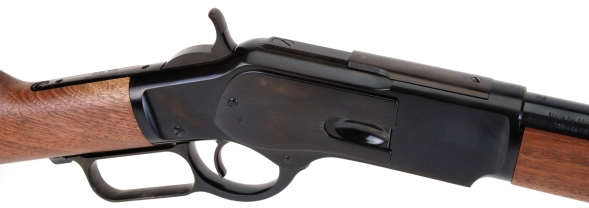
The Winchester Model 1873 was a major improvement over the Winchester Model 1866, as detailed in Part 1 . Key was the change from .44 Henry rimfire to the .44 Winchester Center Fire, or 44-40 Winchester as it is more commonly known today. The .44 W.C.F. retained the 200 grain bullet of the rimfire Henry, however, the .44 W.C.F.’s thicker brass case permitted an increase in powder charge over the thin copper 44 Henry case. With a bump from 25 grains to 40 grains of black powder, 24″ barrel velocity increased from 1125 FPS to 1325 FPS, giving the .44 W.C.F. the ability to penetrate 4″ of pine board at 1,000 yards. 1) Bored cowboys and fence posts in peril.
The .44-40 Winchester… A misconception in axiom’s clothing
For the sake of due diligence in preparation for handloading the .44-40 W.C.F., I read and researched and read some more; horror stories, trials and tribulations, cures, fixes, inventions and theories. There were support groups and interventions for .44-40 Winchester reloaders. It appeared as though I would need 4 sets of reloading dies, custom crimping tools, a lot of lead for slugging bores and a selection of bullets from 0.425″ through 0.431″ in 0.001″ increments. I would also need 50% more brass than the planned number of loaded cartridges to account for squashed neck attrition. In the end, I set up the reloading bench, planned on a hard landing in Spain, but ended up in San Francisco with a disinterested flight attendant palm waving “Buh-Bye”.
Bottle neck or straight up…
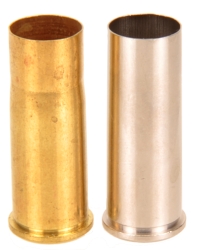 The .44-40 W.C.F. is not a magnum waiting to be awakened by a handloader, Buffalo Bore, or by me for that matter. The design of the Winchester Model 1873 design is more than adequate, as is the .44-40 W.C.F. brass, but the combination is intended for modest pressure. If hot dogging is desired, the high performance stubby round solution would be the Winchester Model 1892 chambered for the .44 Rem Mag or .45 Colt.
The .44-40 W.C.F. is not a magnum waiting to be awakened by a handloader, Buffalo Bore, or by me for that matter. The design of the Winchester Model 1873 design is more than adequate, as is the .44-40 W.C.F. brass, but the combination is intended for modest pressure. If hot dogging is desired, the high performance stubby round solution would be the Winchester Model 1892 chambered for the .44 Rem Mag or .45 Colt.
The .44-40 W.C.F. is a bottle neck case, as illustrated by the Remington brass, far left, but not so much by Starline brass, near left… although it will become bottle necked when first fired. Perhaps Starline should label their product, “Almost finished”. I’ve heard two excuses for the lack of shoulders on Starline brass. The first suggests this removes fragile shoulders that frequently collapse, the second suggests that the creation of a linear case taper improves ballistic performance.
As to the first, if a shoulder collapses while handloading, either tools or components are defective or the handloader is doing something wrong within the process. My anecdotal evidence? The round has been around in bottle neck form since 1873. One of Winchester’s first accessories was a reloading tool. If a cowboy of 140 years ago… who lived on the range, whose horse and his cattle were his only companions… was able to reload this round, there is no reason why a modern handloader can’t reload the same cartridge without a design or divine intervention.2)
The second issue of improved ballistics? Ever look at a ballistic table for the .44-40 W.C.F.? It would take a uniformly tapered case AND a lightening strike to make a difference in ballistic performance. Here’s my theory. Starline saves a penny a case by removing the secondary operation (s) required to form the shoulder.
Bore diameter perspectives. Make sure you look both ways…
It is common for folks to insist that a .44 W.C.F. bore should be slugged to determine proper bullet diameter before attempting handloading. The suggestion once was only to be applied to original production firearms where variation from one manufacturer to the next was common. However, now the same directive is chanted for replicas and new Winchester production even in the presence of both SAAMI and CIP specifications. Unfortunately, few directors note the need to check the chamber diameter that contains the cartridge neck of the loaded round.
The SAAMI spec for .44-40 Winchester bullet diameter is 0.427″ -0.003″/+ 0.0″. Current production Winchester groove/bore diameter is 0.4285″/0.4224″ which seems to suggest the possible use of popular 0.429″ bullets… but not really. The .44-40 Winchester chamber specification at the case mouth is 0.4436″. Tolerance is +.002″/-0.000″. The .44-40 Winchester bullet diameter specification is 0.427″ -0.003/+0.000″. Cartridge case material specification is 0.008″ wall thickness for a total assembled diameter increase of 0.016″. Assembled, it is possible to have a maximum neck diameter, with bullet seated, of 0.443″, or about the same as the minimum chamber neck specification and 0.002″ under maximum.

 In this case, the Hunters Supply green lubed cast bullets pictured above measure uniformly 0.4275″. The knurled Hornady bullet measured 0.425. Both Remington and Starline brass were thinner than maximum material thickness specification, so assembled rounds measured 0.442″; under the minimum chamber neck diameter spec.
In this case, the Hunters Supply green lubed cast bullets pictured above measure uniformly 0.4275″. The knurled Hornady bullet measured 0.425. Both Remington and Starline brass were thinner than maximum material thickness specification, so assembled rounds measured 0.442″; under the minimum chamber neck diameter spec.
Jacketed bullets labeled 0.429″ actually measured 0.430″ to 0.431″ depending on bullet weight and manufacturer. Ammunition assembled with jacketed bullets measured 0.445″ to 0.447″ and they would not chamber in the modern Winchester rifle. So while the bore and groove diameter might accommodated larger than spec diameter bullets, the chamber would not. The jacketed bullet solution? Use the correct bullets. Both Winchester and Remington offer thin jacketed 0.426″ bullets for the .44-40 Winchester, both 200 grain, but these days they are a rarity. Cast bullets offer the best availability and diversity.
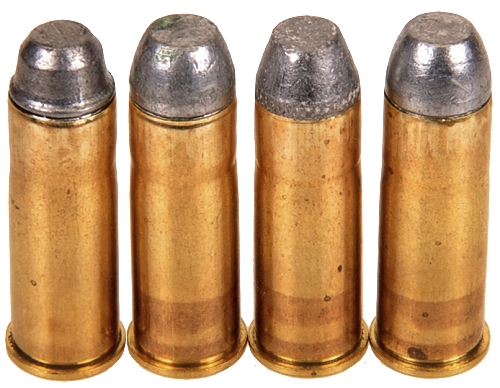
Above, with a number of experimental crimps, roll and factory. The largest assembled cartridge measured 0.443″ in diameter at the crimp, but more typically assembled cartridges measured 0.441″. All chambered and ejected cleanly. All retained bullets as loaded. All cases accepted primers normally. All cases were sized, expanded and loaded routinely without losing a single case on the bench turret press.
Handload data below…

Warning: Bullet selections are specific, and loads are not valid with substitutions of different bullets of the same weight. Variations in bullet length will alter net case capacity, pressure and velocity. Primer selection is specific and primer types are not interchangeable. These are maximum loads in my firearms and may easily be excessive in others. All loads should be reduced by 5%, and developed following safe handloading practices as represented in established reloading manuals produced by component manufacturers. Presentation of these loads does not constitute a solicitation for their use, nor a recommendation.
|
Cartridge: .44 W.C.F. (44-40) |
|
| Rifle: Modern Winchester Model 1873 | Max COL: 1.592″ |
| *Bullet Diameter: 0.427″ + 0.429″ | Primer: CCI 300 |
| Barrel: 20″ | Reloading Dies: Lee Precision |
| Max case length: 1.305″ | Group distance: 50 yards |
|
* Modern Winchester bore/groove diameter 0.4225″ / 0.4285″ |
|
| Bullet | Bullet Weight Grains |
Net Water Capacity H2O |
COL” | Powder Type | Powder Charge Grains |
Muzzle Velocity FPS |
Muzzle Energy Ft-Lbs |
*50 Yard Group Size 5 Shot “ |
|
| Hunters Supply | 160 | 31.0 | 1.575 | Alliant Re7 | 27.0 | 1317 | 616 | 1.0 | |
| Hunters Supply | 160 | 31.0 | 1.575 | Alliant 10x | 29.0 | 1360 | 657 | 1.4 | |
| Hunters Supply | 200 | 29.1 | 1.595 | Benchmark | 27.0 | 1131 | 568 | 0.9 | |
| Hunters Supply | 200 | 29.1 | 1.595 | Norma 201 | 30.0 | 1220 | 661 | 0.9 | |
| Hornady Cowboy | 205 | 27.5 | 1.570 | Benchmark | 26.0 | 1128 | 579 | 1.1 | |
| Hornady Cowboy | 205 | 27.5 | 1.570 | IMR 4227 | 20.0 | 1182 | 636 | 0.8 | |
| Hunters Supply | 240 | 25.6 | 1.596 | Alliant Re7 | 21.0 | 1152 | 707 | 1.0 | |
| Hunters Supply | 240 | 25.6 | 1.596 | Benchmark | 23.0 | 993 | 526 | 1.2 | |
| Hunters Supply | 240 | 25.6 | 1.596 | Norma 201 | 26.0 | 1067 | 607 | 1.1 | |
|
* Semi |
|||||||||
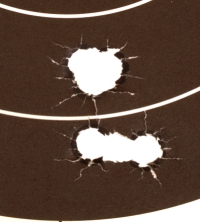 Most of the load data available was based on fast burning pistol powder and very light charges, but the .44-40 Winchester has nearly the same capacity as a .30-30 Winchester. So I slowed down the burn rates, filled up the cases and got some accurate handloads with decent velocity for the 20″ barrel rifle.
Most of the load data available was based on fast burning pistol powder and very light charges, but the .44-40 Winchester has nearly the same capacity as a .30-30 Winchester. So I slowed down the burn rates, filled up the cases and got some accurate handloads with decent velocity for the 20″ barrel rifle.
I suppose I am in the minority for liking the factory open sights. Might be because I learned how to shoot a centerfire rifle with these types of sights and used them for years. From a rest with the brass bead settled into the small “U” notch at the bottom of the rear sight, aiming is quite precise and a shooting rest is quite stable.
For me, shooting the Model 1873 was quite different from many other lever action rifles. Noise is moderate and recoil is non-existent. With the mortise cover back, the breech bolt and case head are in clear view and quite simplistic compared to a Model 1892’s or Model 1886’s vertical locking bolt and guide rails. By comparison, the Model 1873 is also very light and fast handling. I could see where it would be very popular with frontiersmen.
Impressions? I can do a great Bogart, ” Play it once, Sam, for old times’ sake…”
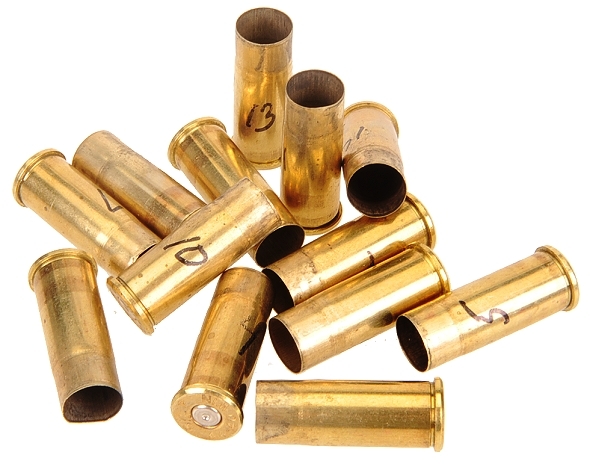
The Winchester Model 1873 Short Rifle was covered in detail in Part 1, but I can add comment for the combination of rifle and .44-40 Winchester. It is an accurate combination, mechanically sound, nicely made, and fun to shoot. I’d guess it would be even more fun competing in cowboy action shooting events.
The .44-40 Winchester is a big bore with a lot of power, significantly above 45 Colt spec loads, but significantly below the 44 Magnum. I realize it was used by sustenance hunters and trappers throughout the Western expansion and used in defense of homesteads, but for me it is a little light for deer hunting. Nice rifle, fun to shoot, well made.
1) The Story of Winchester 1 of 1000 and 1 of 100 Rifles – Lewis
2) Sweet Baby James – James Taylor
Winchester’s Model 1873 Short Rifle Part 1
Winchester’s Model 1873 Short Rifle Part 2

Email Notification